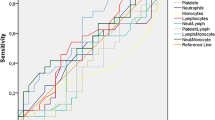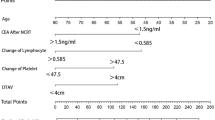Abstract
Purpose
The objective of this study was to evaluate whether change of white blood-cell (WBC) count before and during chemoradiotherapy (CRT) might be associated with susceptibility to radiation and tumor response.
Methods
Medical records of 641 patients with rectal cancer who received preoperative CRT followed by curative surgery were retrospectively reviewed in five tertiary centers. Complete blood cell with differential count was measured weekly during the period of CRT. We assessed nadir/pre-CRT ratio of WBC count as a predictor for tumor response to CRT and a prognostic factor for recurrence-free survival.
Results
Enrolled patients were divided into low WBC ratio (LWR) and high WBC ratio (HWR) arms with cut-off value of 0.49 calculated by receiver operating characteristic curve. Of 641 patients, 490 (76.4%) and 151 (23.6%) were categorized into HWR (> 0.49) arm and LWR (≤ 0.49) arms, respectively. Complete pathologic response rate after CRT was significantly higher in LWR arm than that in HWR arm (23.8% vs. 12.2%, p = 0.001). In logistic regression analysis, carcinoembryonic antigen (CEA) level over 5 ng/ml [adjusted odds ratio (OR) 0.566, 95% confidence interval (CI) 0.351–0.912; p = 0.019) and HWR (adjusted OR 0.412, 95% CI 0.256–0.663; p = 0.001) were significantly negative factors of pathologic complete response. The 5-year recurrence-free survival rate was significantly higher in the LWR group than that in the HWR group (83.3% vs. 67.6%, p = 0.001).
Conclusion
Low nadir/pre-chemoradiotherapy ratio during preoperative CRT can predict good tumor response. It is significantly associated with improved recurrence-free survival in rectal cancer.



Similar content being viewed by others
References
MacFarlane JK, Ryall RD, Heald RJ (1993) Mesorectal excision for rectal cancer. Lancet 341:457–460
Song JH, Jeong JU, Lee JH, Kim SH, Cho HM, Um JW, Jang HS, Korean Clinical Practice Guideline for Colon and Rectal Cancer Committee (2017) Preoperative chemoradiotherapy versus postoperative chemoradiotherapy for stage II-III resectable rectal cancer: a meta-analysis of randomized controlled trials. Radiat Oncol J 35:198–207
Gérard J-P, Conroy T, Bonnetain F, Bouché O, Chapet O, Closon-Dejardin MT, Untereiner M, Leduc B, Francois É, Maurel J, Seitz JF, Buecher B, Mackiewicz R, Ducreux M, Bedenne L (2006) Preoperative radiotherapy with or without concurrent fluorouracil and leucovorin in T3-4 rectal cancers: results of FFCD 9203. J Clin Oncol 24:4620–4625
Bosset J-F, Collette L, Calais G, Mineur L, Maingon P, Radosevic-Jelic L, Daban A, Bardet E, Beny A, Ollier JC, EORTC Radiotherapy Group Trial 22921 (2006) Chemotherapy with preoperative radiotherapy in rectal cancer. N Engl J Med 355:1114–1123
Collette L, Bosset JF, den Dulk M, Nguyen F, Mineur L, Maingon P, Radosevic-Jelic L, Piérart M, Calais G, European Organisation for Research and Treatment of Cancer Radiation Oncology Group (2007) Patients with curative resection of cT3-4 rectal cancer after preoperative radiotherapy or radiochemotherapy: does anybody benefit from adjuvant fluorouracil-based chemotherapy? A trial of the European Organisation for Research and Treatment of Cancer radiation oncology group. J Clin Oncol 25:4379–4386
Sauer R, Becker H, Hohenberger W, Rödel C, Wittekind C, Fietkau R, Martus P, Tschmelitsch J, Hager E, Hess CF, Karstens JH, Liersch T, Schmidberger H, Raab R, German Rectal Cancer Study Group (2004) Preoperative versus postoperative chemoradiotherapy for rectal cancer. N Engl J Med 351:1731–1740
Govindarajan A, Reidy D, Weiser MR, Paty PB, Temple LK, Guillem JG, Saltz LB, Wong WD, Nash GM (2011) Recurrence rates and prognostic factors in ypN0 rectal cancer after neoadjuvant chemoradiation and total mesorectal excision. Ann Surg Oncol 18:3666–3672
Maas M, Nelemans PJ, Valentini V, Crane CH, Capirci C, Rödel C, Nash GM, Kuo LJ, Glynne-Jones R, García-Aguilar J, Suárez J, Calvo FA, Pucciarelli S, Biondo S, Theodoropoulos G, Lambregts DMJ, Beets-Tan RGH, Beets GL (2015) Adjuvant chemotherapy in rectal cancer: defining subgroups who may benefit after neoadjuvant chemoradiation and resection: a pooled analysis of 3,313 patients. Int J Cancer 137:212–220
Maas M, Nelemans PJ, Valentini V, Das P, Rödel C, Kuo LJ, Calvo FA, García-Aguilar J, Glynne-Jones R, Haustermans K, Mohiuddin M, Pucciarelli S, Small W Jr, Suárez J, Theodoropoulos G, Biondo S, Beets-Tan RGH, Beets GL (2010) Long-term outcome in patients with a pathological complete response after chemoradiation for rectal cancer: a pooled analysis of individual patient data. Lancet Oncol 11:835–844
Coussens LM, Werb Z (2002) Inflammation and cancer. Nature 420:860–867
Erlinger TP, Platz EA, Rifai N, Helzlsouer KJ (2004) C-reactive protein and the risk of incident colorectal cancer. JAMA 291:585–590
Forrest LM, McMillan DC, McArdle CS et al (2003) Evaluation of cumulative prognostic scores based on the systemic inflammatory response in patients with inoperable non-small-cell lung cancer. Br J Cancer 89:1028–1030
Hanahan D, Weinberg RA (2011) Hallmarks of cancer: the next generation. Cell 144:646–674
Fankhauser CD, Sander S, Roth L, Gross O, Eberli D, Sulser T, Seifert B, Beyer J, Hermanns T (2018) Systemic inflammatory markers have independent prognostic value in patients with metastatic testicular germ cell tumours undergoing first-line chemotherapy. Br J Cancer 118:825–830
McMillan DC (2013) The systemic inflammation-based Glasgow prognostic score: a decade of experience in patients with cancer. Cancer Treat Rev 39:534–540
McMillan DC, Crozier JEM, Canna K et al (2007) Evaluation of an inflammation-based prognostic score (GPS) in patients undergoing resection for colon and rectal cancer. Int J Color Dis 22:881–886
Cho Y, Kim KH, Yoon HI, Kim GE, Kim YB (2016) Tumor-related leukocytosis is associated with poor radiation response and clinical outcome in uterine cervical cancer patients. Ann Oncol 27:2067–2074
Khan AA, Akritidis G, Pring T, Alagarathnam S, Roberts G, Raymond R, Varcada M, Novell R (2016) The neutrophil-to-lymphocyte ratio as a marker of lymph node status in patients with rectal cancer. Oncology 91:69–77
Kim IY, You SH, Kim YW (2014) Neutrophil-lymphocyte ratio predicts pathologic tumor response and survival after preoperative chemoradiation for rectal cancer. BMC Surg 14:94
Sung S, Son SH, Park EY, Kay CS (2017) Prognosis of locally advanced rectal cancer can be predicted more accurately using pre- and post-chemoradiotherapy neutrophil-lymphocyte ratios in patients who received preoperative chemoradiotherapy. PLoS One 12:e0173955
Shen L, Zhang H, Liang L, Li G, Fan M, Wu Y, Zhu J, Zhang Z (2014) Baseline neutrophil-lymphocyte ratio (>/=2.8) as a prognostic factor for patients with locally advanced rectal cancer undergoing neoadjuvant chemoradiation. Radiat Oncol 9:295
Caputo D, Caricato M, Coppola A, la Vaccara V, Fiore M, Coppola R (2016) Neutrophil to lymphocyte ratio (NLR) and derived neutrophil to lymphocyte ratio (d-NLR) predict non-responders and postoperative complications in patients undergoing radical surgery after neo-adjuvant radio-chemotherapy for rectal adenocarcinoma. Cancer Investig 34:1–12. https://doi.org/10.1080/07357907.2016.1229332
Garcia-Barros M, Paris F, Cordon-Cardo C, Lyden D, Rafii S, Haimovitz-Friedman A, Fuks Z, Kolesnick R (2003) Tumor response to radiotherapy regulated by endothelial cell apoptosis. Science 300:1155–1159
Vatner RE, Formenti SC (2015) Myeloid-derived cells in tumors: effects of radiation. Semin Radiat Oncol 25:18–27
Kim YJ, Kim JH, Yu CS, Kim TW, Jang SJ, Choi EK, Kim JC, Choi W (2017) Effect of time interval between capecitabine intake and radiotherapy on local recurrence-free survival in preoperative chemoradiation for locally advanced rectal cancer. Radiat Oncol J 35:129–136
Kim JH (2017) Controversial issues in radiotherapy for rectal cancer: a systematic review. Radiat Oncol J 35:295–305
Acknowledgements
Statistical analyses performed in this article were advised by Catholic Medical Center Clinical Research Coordinating Center.
Author information
Authors and Affiliations
Corresponding author
Ethics declarations
Each center obtained approval from respective Institutional Review Board before enrolling patients.
Conflict of interest
The authors declare that they have no conflict of interest.
Rights and permissions
About this article
Cite this article
Lee, J.H., Jeong, J.U., Kim, S.H. et al. Nadir/pre-chemoradiotherapy ratio of white blood-cell count can predict tumor response and recurrence-free survival in locally advanced rectal cancer: a multi-institutional analysis. Int J Colorectal Dis 34, 105–112 (2019). https://doi.org/10.1007/s00384-018-3174-8
Accepted:
Published:
Issue Date:
DOI: https://doi.org/10.1007/s00384-018-3174-8




